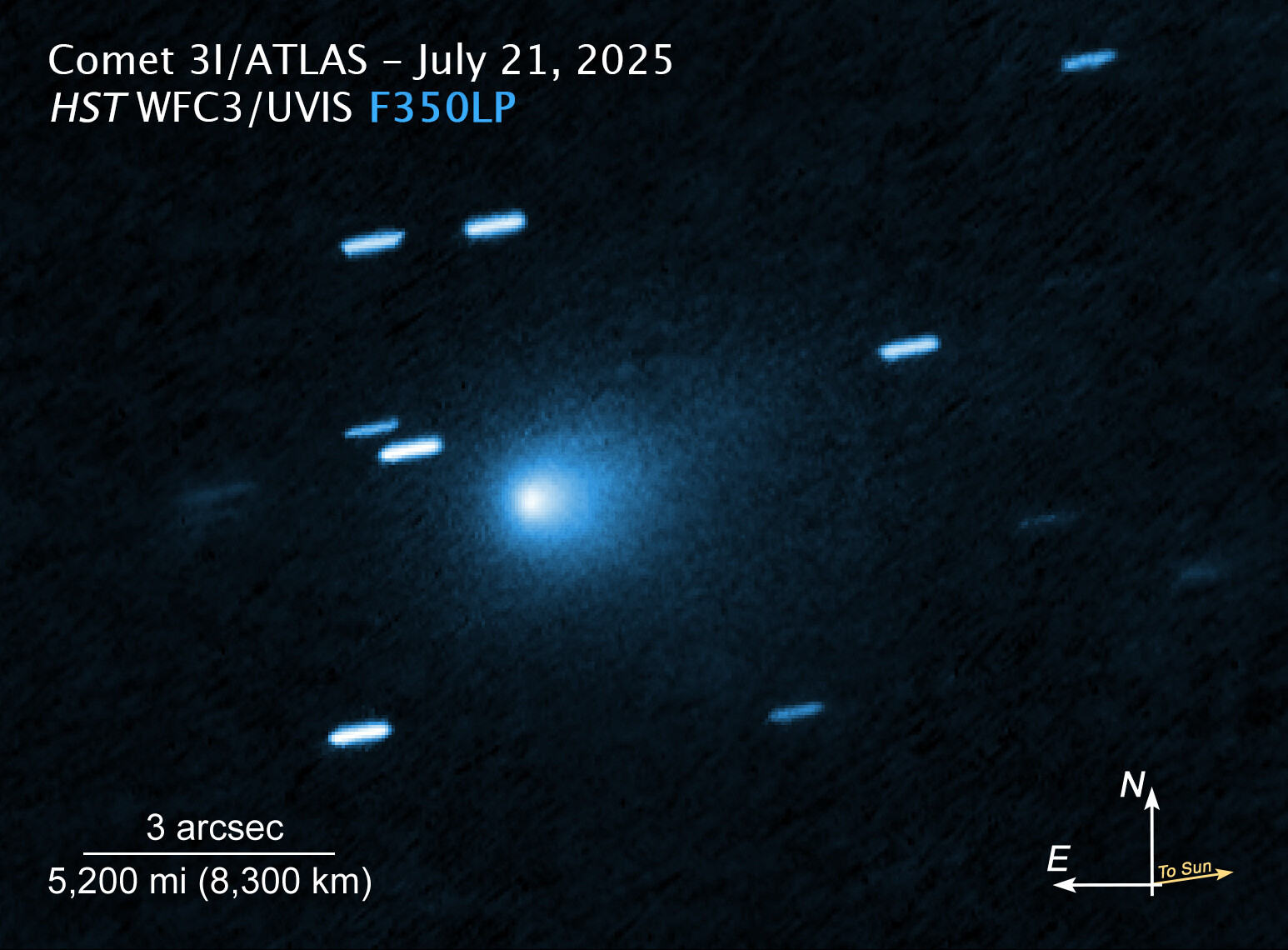Science
Astronomers Alarmed by 3I/ATLAS: Could It Be Alien Technology?

A celestial object named 3I/ATLAS has sparked significant concern among scientists and the public alike after its detection in July 2023. This object, estimated to measure nearly 13 miles (approximately 21 kilometres) in diameter, was first discovered by the ATLAS survey in Hawaii. Its unusual composition has led to speculation about the possibility of extraterrestrial technology.
Researchers have identified that 3I/ATLAS emits metallic vapour containing nickel and chromium—elements commonly found in high-temperature industrial alloys but not in naturally occurring celestial bodies. This revelation has raised eyebrows within the scientific community. Dr. Avi Loeb, an astrophysicist at Harvard University, described the find as “unprecedented,” noting that the material’s spectral signature “does not match any natural asteroid or comet we’ve catalogued.” His remarks echo his previous discussions surrounding ‘Oumuamua, another interstellar object observed in 2017.
Initial spectroscopic readings obtained by observatories in Chile and Spain indicated metallic emissions consistent with Inconel-type alloys, materials used in aerospace applications. The presence of nickel-chromium alloys is particularly striking, as they require extremely high melting points—conditions typically found only in complex industrial processes, not in space.
In addition to its unusual composition, 3I/ATLAS exhibits non-gravitational motion, implying some form of propulsion or atypical outgassing. Observations also indicate that the object’s surface reflectivity is remarkably high, aligning with polished metal rather than natural rock or ice.
Experts are cautious, urging against hasty conclusions about the object’s origin. Dr. Laura Benton from the European Southern Observatory stated, “While no one is declaring ‘alien hardware’ just yet, the data forces us to question our assumptions about what’s naturally possible in the interstellar medium.”
As news of 3I/ATLAS spread, social media erupted with speculation, with hashtags like #AlienAlloy and #AtlasProbe trending on platforms such as X (formerly Twitter). Some users have even posited that government agencies might be monitoring the object for potential retrieval. In response to these theories, NASA issued a statement downplaying any imminent threat, asserting that 3I/ATLAS is expected to exit the Solar System by 2026.
Despite the ongoing excitement, scientists are committed to gathering more data before reaching definitive conclusions. Dr. Loeb’s research group at Harvard’s Galileo Project is employing high-resolution telescopes to track the object’s trajectory and analyze its emissions more closely. Furthermore, international space agencies are contemplating a collaborative observation campaign to capture clearer imagery of 3I/ATLAS as it approaches perihelion later this year.
Whether 3I/ATLAS is a remnant of advanced alien engineering or an extraordinary anomaly of cosmic chemistry remains to be seen. Nevertheless, its presence has captivated both scientists and the public, prompting broader discussions about the nature of materials in space. For now, this metallic visitor continues its enigmatic journey through our Solar System, posing profound questions that challenge our understanding of the universe.
-

 Health2 months ago
Health2 months agoNeurologist Warns Excessive Use of Supplements Can Harm Brain
-

 Health3 months ago
Health3 months agoFiona Phillips’ Husband Shares Heartfelt Update on Her Alzheimer’s Journey
-

 Science3 weeks ago
Science3 weeks agoBrian Cox Addresses Claims of Alien Probe in 3I/ATLAS Discovery
-

 Science3 weeks ago
Science3 weeks agoNASA Investigates Unusual Comet 3I/ATLAS; New Findings Emerge
-

 Science2 weeks ago
Science2 weeks agoScientists Examine 3I/ATLAS: Alien Artifact or Cosmic Oddity?
-

 Science2 weeks ago
Science2 weeks agoNASA Investigates Speedy Object 3I/ATLAS, Sparking Speculation
-

 Entertainment4 months ago
Entertainment4 months agoKerry Katona Discusses Future Baby Plans and Brian McFadden’s Wedding
-

 World2 months ago
World2 months agoCole Palmer’s Cryptic Message to Kobbie Mainoo Following Loan Talks
-

 Entertainment3 months ago
Entertainment3 months agoEmmerdale Faces Tension as Dylan and April’s Lives Hang in the Balance
-

 Science2 weeks ago
Science2 weeks agoNASA Scientists Explore Origins of 3I/ATLAS, a Fast-Moving Visitor
-

 Entertainment4 months ago
Entertainment4 months agoLove Island Star Toni Laite’s Mother Expresses Disappointment Over Coupling Decision
-

 Entertainment3 months ago
Entertainment3 months agoMajor Cast Changes at Coronation Street: Exits and Returns in 2025









